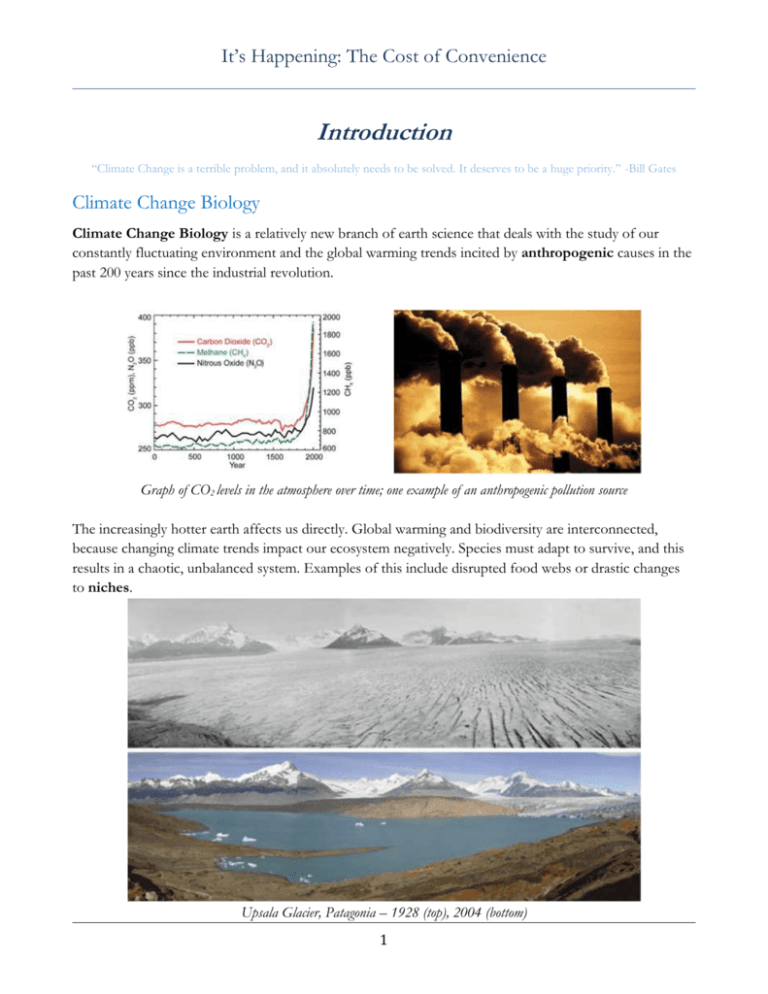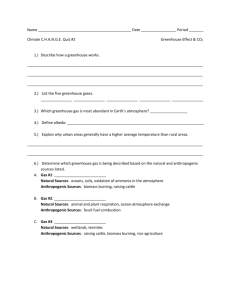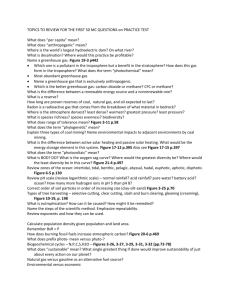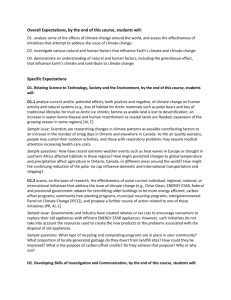kornbergedit - TheCostofConvenience
advertisement

It’s Happening: The Cost of Convenience Introduction “Climate Change is a terrible problem, and it absolutely needs to be solved. It deserves to be a huge priority.” -Bill Gates Climate Change Biology Climate Change Biology is a relatively new branch of earth science that deals with the study of our constantly fluctuating environment and the global warming trends incited by anthropogenic causes in the past 200 years since the industrial revolution. Graph of CO2 levels in the atmosphere over time; one example of an anthropogenic pollution source The increasingly hotter earth affects us directly. Global warming and biodiversity are interconnected, because changing climate trends impact our ecosystem negatively. Species must adapt to survive, and this results in a chaotic, unbalanced system. Examples of this include disrupted food webs or drastic changes to niches. Upsala Glacier, Patagonia – 1928 (top), 2004 (bottom) 1 It’s Happening: The Cost of Convenience Thus, it is our job to protect our Earth by mitigating climate change. Important practices that come to mind are conservation and sustainability. We need to control the harm we inflict on the biosphere. To understand climate change, we first have to understand the natural greenhouse effect, first discovered by Swedish chemist Svante Arrhenius in 1896. In this phenomena grammar issue conflicting plural, certain gases in the atmosphere trap heat (in the form of infrared radiation) in the atmosphere. This is important because without greenhouse gases, our planet would be as freezing cold as Mars (-60C to 120C) and inhospitable for life. These gases, including Carbon Dioxide (CO2), Ozone (O3), Methane (CH4), and Water Vapor (H2O) form a heat blanket for Earth. Diagram demonstrating the principles behind the greenhouse effect So, the natural greenhouse effect helps keep Earth hospitable for all living things. However, when certain greenhouse gas levels rise substantially, then the natural effect is enhanced, and traps more infrared radiation than needed. This unnatural rise in greenhouse gas levels is attributed to human activities, including fossil fuel burning, deforestation, and manufacturing with chemicals such as Chloroflourocarbons (CFCs). 2 It’s Happening: The Cost of Convenience Graphic representation of radiative energy flow to and from Earth Today we are pumping out methane, nitrous oxide, carbon dioxide and CFCs at an alarming rate. The Preindustrial Level, or the atmospheric concentration of CO2 and the beginning of the industrial revolution, was only 280PPM. In fact, for the past 1800 years the CO2 concentration had wavered between 250 and 300PPM. As of now we are at 400PPM, as seen in the graph at the beginning of this chapter. Climate change is a real issue, and we need to be proactive in solving it Tie this more in to carbon levels, too abrupt a change. Global Temperature over the last 500 million years Part of what makes the climate change hard for some to accept is that it can be difficult to separate the natural and anthropogenic causes of climate change needs short sentence discussing why that makes it hard. Without human interaction, Earth’s climate changes over time, sometimes in radical ways. There are a variety of causes for this, for example changes in incoming solar radiation due to the Milankovitch Effect, or natural changes in the levels of greenhouse gasses. Due to the complexity of separating these 3 It’s Happening: The Cost of Convenience two sources of climate change, we will make a particular effort in this book to show, using data, models, and simulations, the difference between these sources and their effects on our current changing climate. 4 It’s Happening: The Cost of Convenience Milankovitch Cycles, one natural source of climate change. Move, Adapt, or Die Since, in this book, we will be showing many examples and places on Earth that have been undergoing climate change, it is important to consider the response of plants and animals to this change. When we consider possible responses to climate change, we find three main options - Move, Adapt, or Die. The most obvious response is simply to move - if the local climate is warming, an animal can simply move to a higher latitude location where the climate is colder. Although plants cannot effectively move, the range of a particular species of plant can change over time as seeds can be spread away from the location of the mother plant. These seeds will have a tendency to grow better in the areas with a climate more suited to the particular plant, and in this manner a plant species may move in response to climate change much like an animal, simply much more slowly. The second possible response is to adapt. A species can, over time, develop different behaviors or even evolve to allow it to handle the change in climate. For example, an animal can learn to prey on new food sources, or a plant species can evolve a different leaf shape better suited to the new climate. While both plants and animals can evolve, only animals can effectively change their behavior - therefore, the plants will again have a much slower response to climate change. The final response to climate change is not really a response but instead a lack of response - if the species is unable to move or adapt quickly enough, it will die out. Consider going over other chapters if you explain these three Book Structure In this section we will introduce some of the different ways that information will be presented in this book. 5 It’s Happening: The Cost of Convenience Vocabulary In this book, key vocabulary from the chapter will be presented in inset Vocab Boxes: Chapter Vocabulary Climate Change Biology - a long-term change in the earth's climate Anthropogenic – caused or produced by humans Niches - the position or function of an organism in a community of plants and animals Biosphere - the part of the earth's crust, waters, and atmosphere that supports life Greenhouse Effect - the trapping of the sun's warmth in a planet's lower atmosphere due to the greater transparency of the atmosphere to visible radiation from the sun than to infrared radiation emitted from the planet's surface Simulations and Models In this book there are a number of models which can help readers visualize the factors that affect climate change. These models can be used to show how the study of climate change is played out with reference to time. In each chapter of this book there will be a related model that will model the specific aspect of our world. For example, in the Move chapter there will be a model to show how plants and animals migrate over time due to influences of climate change. Another example of how models are useful include plant modeling in the phenology chapter. While there are numerous ways of constructing simulations and models, including both computational and mathematical models, one type of model in particular is useful for studying many climate change systems. This is the differential-equation based model, which uses a set of rate equations to model a changing system based on a set of initial conditions. One program that facilitates the study of this type of model is VenSim, which provides a graphical user interface for constructing differential-equation based models. Seems tacked on for an end sentence Case Studies Case studies are a way of investigating a research question, and are especially useful in scenarios where the individual variables, events, or actions cannot be easily managed and controlled by the researcher. Case studies often provide a valuable insight into modern, real-world problems, by investigating similar situations. Using inductive reasoning, by generalizing specific scenarios into a wider scope, allows case studies to be conducted on a small and local scale, yet help to answer global questions. For example, a case study examining a small population of penguins on a shrinking area of an icecap could allow researchers to generalize their findings to other populations or even species elsewhere. 6 It’s Happening: The Cost of Convenience There are a few special types of case studies that can be employed in different scenarios to better fit the problem at hand. Illustrative case studies are focused mainly on describing a scenario, instead of answering a specific research question. Exploratory case studies allow researchers to better understand a problem, with the goal of enabling future, more focused research in the area. Cumulative case studies involve the aggregation of multiple existing case studies with a similar focus, allowing possibly new conclusions to be drawn without significant additional research effort. Critical Instance case studies are often used in exploring unique situations, often for use in cause-and-effect analysis or for providing counter-examples to other research findings. Labs and Activities Various labs and activities will be presented in this book that should enable the reader to better understand the concepts presented. These interactive, hands-on activities allow the reader to gain a deeper understanding of the concepts by actually seeing the causes and effects of a specific area of study in a reallife physical setting, instead of simply by reading about a concept which may be hard to conceptualize or understand. These tactile labs and activities also greatly assist those who may not have a visual or auditory learning style, by better tailoring the material to how they learn best - by actually doing something and seeing what happens. This last sentence seems a little out of place Six Big Ideas When investigating material relating to Environmental Biology, it is important to keep in mind the 6 big ideas of Environmental Biology. They are: 1. 2. 3. 4. 5. 6. Science is a process Energy conversions underlie all ecological processes The Earth itself is one interconnected system Humans alter natural systems Environmental problems have a cultural and social context Human survival depends on developing practices that will achieve sustainable systems Would be better not to just list these out, slight explanation By considering these ideas, we will better be able to understand the complex ideas presented in this book. Associated Online Content The website associated with this textbook, http://thecostofconvenience.wikispaces.com/, hosts various associated content which supports the chapters – often with visual aids such as videos or interactive models. For example, in the Introduction section of this website, the reader will find an interview of a sample of high-school students and their reactions to two simple questions relating to the topic of this book, which provides a perspective to the motivation for writing this textbook. All images in this chapter were located in the following source: 7 It’s Happening: The Cost of Convenience Hannah, Lee Jay. Climate Change Biology. Burlington, MA: Academic, 2011. Ebook. Work on this chapter and associated content was performed by Zack Polizzi and Jenny Wang, and was relatively evenly split between each. 8








